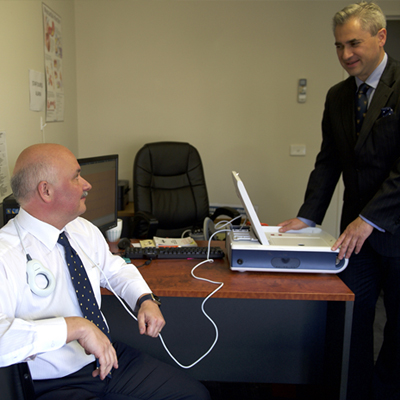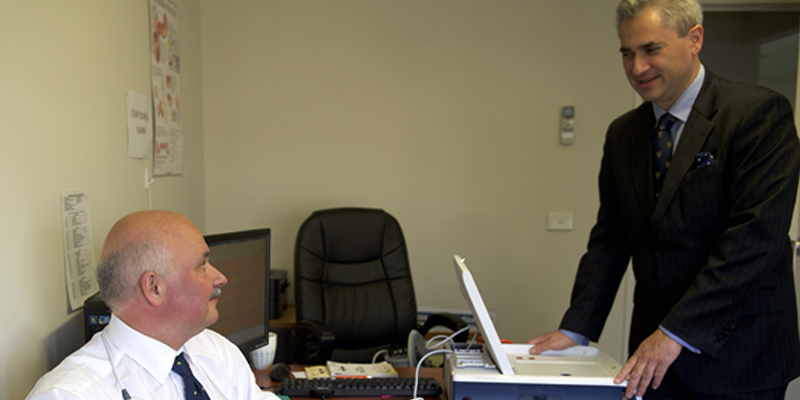
Pacemaker Surgery

Pacemaker surgery is a medical procedure that involves the implantation of a small, battery-operated device called a pacemaker. It is a safe and effective procedure for treating certain heart rhythm problems, such as bradycardia (a slow heartbeat) or heart block, and can help improve the patient’s quality of life.
What is a pacemaker?
A pacemaker is a small electronic device that is implanted beneath the skin, typically below the collarbone, to help regulate the heartbeat and treat certain heart rhythm problems. The pacemaker contains a battery and electronic circuits that generate electrical impulses to stimulate the heart to beat if needed.
The pacemaker is connected to the heart using one or more thin wires called leads. The leads are passed through a vein and into the heart, where they are positioned in a specific location to sense the heart’s electrical signals and deliver a small electrical impulse to stimulate the heart to beat if needed.
Pacemakers are used to treat certain heart rhythm problems, such as bradycardia (a slow heartbeat) or heart block, and can help improve the patient’s quality of life. The pacemaker can be programmed to deliver electrical impulses at a specific rate or in response to changes in the heart’s electrical activity, and can also be monitored and adjusted by a healthcare provider to ensure that it is functioning properly.
Pacemakers are typically implanted during a minimally invasive procedure that takes about 1 to 2 hours to complete. After the surgical procedure, patients will need to stay in the hospital for observation for a short period of time and may need to limit certain activities for a few weeks while the incision site heals.
Why would I need a pacemaker?
A pacemaker may be recommended for you if you have a heart condition that affects your heart’s electrical system and causes a slow or irregular heartbeat. Some common reasons why a pacemaker may be needed include:
Bradycardia
If your heart beats too slowly (bradycardia), a pacemaker can be used to help maintain a normal heart rate.
Heart Block
If the electrical signals in your heart are not conducted properly and there is a blockage of the electrical impulses, a pacemaker can be used to help regulate your heart’s rhythm.
Heart Failure
In some cases, a pacemaker can be used to coordinate the electrical signals between the chambers of your heart to improve your heart’s function and reduce symptoms of heart failure.
Certain Medications
Some medications used to treat heart conditions can cause a slow heart rate, which may require a pacemaker.
If you have any concerns about your heart rhythm or have been diagnosed with a heart condition that may require a pacemaker, it is important to talk to your doctor or a cardiology specialist to determine the best treatment plan for you.
What are the risks associated with a pacemaker?
While pacemaker surgery is generally considered safe, as with any medical procedure, there are some risks associated with the insertion of a pacemaker. Some possible risks of pacemaker surgery include:
- A small risk of infection at the site where the pacemaker is inserted.
- Bleeding or bruising may occur at the site where the pacemaker is inserted.
- Some people may have an allergic reaction to the materials used in the pacemaker or to the anesthesia used during the procedure.
- In rare cases, the lungs may be punctured during the procedure, causing air to leak into the chest cavity.
- During the procedure, there is a small risk of damage to the heart or blood vessels.
- Pacemakers can malfunction or fail, which may require additional surgery to replace or repair the device.
What should I do before pacemaker surgery?
Preparing for a pacemaker involves several steps to ensure that the procedure goes smoothly and that you have a quick and comfortable recovery. Here are some things you can do to prepare for a pacemaker implantation:
Inform your doctor about your medical history
Before the procedure, your doctor will review your medical history to determine if you have any conditions or medications that could interfere with the surgery. Inform your doctor about any medications you are taking, including over-the-counter medications and herbal supplements.
Fasting
In most cases, you will be asked to avoid eating or drinking anything for several hours before the procedure. Your doctor will give you specific instructions on when to stop eating and drinking.
Medication adjustments
Your doctor may need to adjust your medications before the procedure. For example, you may need to stop taking certain medications that could increase your risk of bleeding.
Arrange for transportation
You will need someone to drive you home after the procedure, as you may feel groggy or disoriented from the anesthesia.
Arrange for help
In the first few days after the procedure, you may need help with everyday tasks such as cooking, cleaning, and lifting.
Wear comfortable clothing
Wear comfortable, loose-fitting clothing on the day of the procedure.
Follow your doctor’s instructions
Your doctor will give you specific instructions on how to prepare for the procedure. Be sure to follow these instructions carefully to ensure a successful procedure and recovery.
What happens during pacemaker surgery?
During pacemaker surgery, the patient is given a local anesthetic to numb the area where the pacemaker will be implanted. The surgeon will then make a small incision, usually below the collarbone, and insert the leads (thin wires) into a vein, which will be guided to the heart. The leads are then connected to the pacemaker device, which is placed under the skin near the incision.
Once the leads are in place, the surgeon will test the pacemaker to ensure that it is working properly and set to the correct settings for the patient’s specific needs. The entire procedure usually takes around 1-2 hours.
What happens after pacemaker surgery?
After pacemaker surgery, the patient is taken to a recovery area where they are monitored closely for a few hours. The patient’s vital signs, such as blood pressure, heart rate, and breathing, are monitored to ensure that they are stable and not experiencing any complications.
The patient may experience some pain or discomfort at the incision site, and pain medication may be prescribed to help manage this. The patient may also be given medicines such as antibiotics to help prevent infection.
The patient is usually able to go home the same day or the following day, depending on the doctor’s recommendation. The doctor will provide instructions on how to care for the incision site and what activities to avoid.
The patient will need to avoid certain physical activities that could damage the pacemaker or interfere with its function, such as lifting heavy objects or using certain electronic devices. The doctor will provide specific instructions on what activities to avoid.
Follow-up appointments with the doctor will be scheduled to monitor the pacemaker and ensure that it is functioning properly. The doctor may also perform periodic tests to check the battery life and adjust the pacemaker settings if necessary.
It is important for the patient to follow all instructions from the doctor and report any unusual symptoms or complications immediately. With proper care and monitoring, most patients are able to resume their normal physical activities after pacemaker surgery.
Where can I go for pacemaker surgery in Melbourne?
If you decide to get pacemaker surgery, you can get help at HeartWest, the largest cardiology group in the western and northwestern corridors of Melbourne, with 4 major locations and 3 satellite sites.
At HeartWest, our qualified experts will provide you with the best cardiology care. You will experience nothing but professionalism, care and courtesy; from your first interaction with our staff, to going through tests, procedures and consultations.
Our cardiologists have expertise in all fields of adult cardiology, including;
- General cardiology
- Heart failure
- Cardiac imaging (including stress echocardiography)
- Interventional cardiology
- Electrophysiology & pacing
- Cardiothoracic surgery
Contact us for efficient and affordable specialist heart care services.
